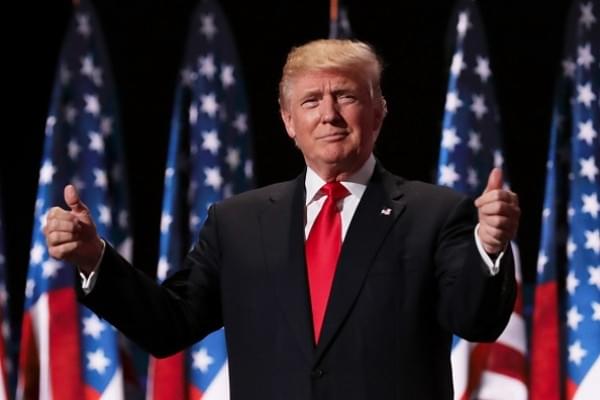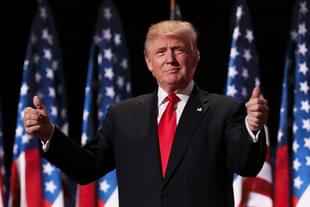World
Trump’s Protectionist Trade Policies Have Dire Consequences For US Businesses
Soumyatanu Mukherjee
Mar 31, 2018, 04:16 PM | Updated 04:15 PM IST
Save & read from anywhere!
Bookmark stories for easy access on any device or the Swarajya app.


Recently, in an opinion-editorial column that appeared in The New York Times, Daniel McCarthy supported United States (US) President Donald Trump’s protectionist trade policies, inclusive of his desire to put steep tariffs on steel and aluminum. Specifically, the populist views on ‘protecting’ America’s interest, through American jobs, wins. However, such a policy also has dire consequences for businesses in America.
One of the main reasons behind President Trump’s rise to power is the belief that import competition, associated with the free-trade agreements, has stagnated the income and growth of middle-class America over the past two decades. When the import tariffs for products imported are increased as a means to protect the interests of the American counterparts, the end consumers bear the tariff. Naturally, this reduces the demand for the imported products, given that the US is one of the major buyers of products.
In the middle of all this, when American companies manufacture and sell the same products without the tariff, there is a consumer switch from the imported product to the domestic product. This results in the fall of the international price of those products. Therefore, the populist political opinion states that fall in world prices is generally much greater than the hike in tariffs (although there should be an ambiguity since this depends on the import elasticity of domestic demand): the domestic price of the product increases at a decreasing rate, implying the gainers still gain while the losers’ loss is limited. Also, as long as the importable good continues to be produced at home, with removal of tariff, the labour-intensive nature of the importable production inherits not only the possibility of an absolute decline in real income, but also the closure of some in-house firms, along with significant retrenchment of the existing American workers. If your import taxes are already lower, the efficiency gains from removal of that become even smaller. This has been the issue with the North American Free Trade Agreement or NAFTA (estimated aggregate gains were between 0 per cent and 0.2 per cent), while the distributional conflict has been the main agenda against China’s World Trade Organization accession (as US manufacturing prices have been reduced by 7 per cent). Therefore, comparing the loss in real income incurred by adversely affected groups to the efficiency gains (which Dani Rodrik described as a “political cost-benefit analysis of globalisation”), President Trump’s protectionist policies may be supported.
However, imposing higher tariffs on steel and aluminium is surely not the ‘first-best’ solution. Let me explain why.
There is a populist notion that import competition results in unemployment. Principally, in the long term, under import competition, wages decline while new investments create different jobs to replace the ones lost due to competition. As a result, the possibility exists that the people who lost their jobs due to import competition might move away to new locations that offer job opportunities because the industries are in decline or have shut down. However, moving away in this situation is not easily feasible because the fall of industries directly results in the fall of real estate. When real estate prices fall, converting fixed investments into liquid resources needed to move, becomes difficult.
In addition, there is also the emotional and social fulcrums that hold people from moving away. President Trump’s policy in this regard is to protect the interests of the people through a protectionist regime. However, protectionism makes economies less efficient, therefore making the whole policy counterproductive. Imposition of a tariff on imports implies less expenditure on imports; however, it also results in the rise of expenditure on domestic production. As a result, US imports reduce, naturally reducing the exports also. This results in one expense negating the other, leaving America with the unsolved original problem – how to ensure Americans get jobs? Narrowing our focus down to the case of tariffs imposed on steel and aluminium, yes, a few more jobs would be created in the steel and aluminium industries, but that would be coupled with significant job losses in the steel-using “downstream” industries, where steel and aluminium are immensely important inputs. Such protectionism will turn the US into a high-cost hub for industrial inputs. Some infant industries would definitely benefit. But at what cost? Other industries (export firms) would be forced to outsource production to stay with countries like Japan, Germany, and China competing in the manufacturing space; while other trading partners may also respond by imposing higher tariffs on US exports, likewise they did in the context of Smoot-Hawley tariffs.
In the aftermath of Trump's tariff announcement, the European Union expressed the willingness to “rebalance” its trading relationship. Further addition to the debate: as Paul Krugman argues, manufacturing in the US roughly constitutes less than 10 per cent of American jobs; and since manufacturing uses lots of service sectors’ inputs, redistribution gains owing to the shift away from trade in manufacturing, would be much less than one and subsequently, job creation would be substantially outweighed by job losses elsewhere.
The potential danger in the whole policy is that the Trump regime would lead to the widening of the budget deficit, mainly through tax cuts. But this may not increase the spending much, as it enables the rich to save their windfall while the poor and the middle class end up facing the crunch. In parallel, the interest rates in the US have finally increased after almost a decade of stable low rates. As a result, US investments stashed abroad, and potentially other foreign investments, have begun to come to the US. This has directly created a demand for the dollar market, strengthening the dollar against other currencies over the past few months. A strong dollar is a good indicator of economic progress; however, it is detrimental to those multinational companies whose livelihood depends on products sold globally. If this policy bears fruit, a secular decline of manufacturing in overall employment remains a strong possibility, which is entirely contradictory to the expectation from the present policies in the US.
Dr Soumyatanu Mukherjee is assistant professor (lecturer), Economics Area, IIM Kozhikode.





